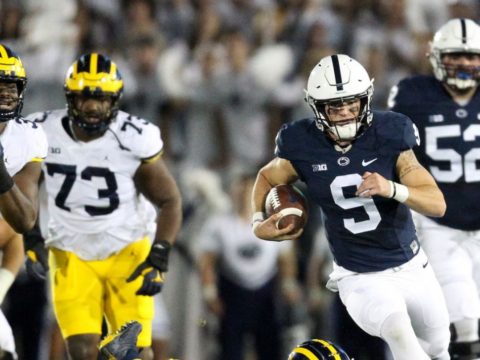
The 2020 Big Ten Football season officially starts this weekend, and the Spartans “kickoff” at noon on Saturday, so we’re trying to peel back the layers of Spartan coaches to get a feel for how they will lead and what type of system they will deploy.
The other day, we shined the spotlight on Chris Kapilovic, the Spartans new Offensive Line Coach and Running Game Coordinator, and we shined the spotlight on William Peagler, the Spartans new Running Back Coach as well.
Today, we shine the spotlight on Jay Johnson the Spartans new Offensive Coordinator and Quarterback Coach.
It’s hard to know “exactly” what type of Offense Jay Johnson will deploy, but statistics provide some very reliable cues.
One thing is clear, the Spartans Offense is in need of a makeover, and the question becomes, can Jay Johnson execute a High Octane makeover, or will the Spartans Offense be more of the same?
I intend to help answer that question.
The Jay Johnson file:
 Jay Johnson is 51 years old and he has coached college football for 25 years.
Jay Johnson is 51 years old and he has coached college football for 25 years.
And while Jay Johnson has been an Offensive Coordinator at different collegiate levels including D-III, D-II and FCS (FCS schools included Southern Mississippi and Louisiana, not to be confused with LSU), nevertheless, Jay Johnson has only been an Offensive Coordinator at the Power 5 level for two years and that was 2016 at University of Minnesota and 2019 at University of Colorado.
History is usually the best predictor of the future, so we will take a closer look at those two small, yet meaningful samples: albeit those samples occurred in two separate seasons, at two different universities, in two different conferences and spanning just two of the past 4 years, yet that is the coaching history that the Spartans new Offensive Coordinator has etched into the record books.
So, let’s start with Jay Johnsons tenure at Minnesota.
University of Minnesota (2016):
As stated, Jay Johnson was Offensive Coordinator at Minnesota for just one season, and it also marked the end of the Jerry Kill era.
As a reminder, Jerry Kill was hired by Minnesota in 2011 to replace Tim Brewster whose tenure was on a downward trajectory as he posted successive records of 7-6; 6-7 and 3-9.
It was a viable decision because Kill had a history of turning around programs including Saginaw Valley State, Emporia State, Southern Illinois, and Northern Illinois.
And true to plan, Jerry Kill turned around Minnesota as well, going 3-9; 6-7; 8-5; and 8-5 and he did it the “old fashioned way” by executing the fundamentals. Nevertheless in 2015, Jerry Kill had serious health problems and had to leave the program in late October. So Tracy Claeys the Gophers highly regarded Defensive Coordinator took over as interim Head Coach and finished 6-7 in a very turbulent season.
Nevertheless, the following season, Tracy Claeys was appointed Head Football Coach at Minnesota, and he hired Jay Johnson as Offensive Coordinator. Minnesota posted a solid 8-4 regular season record, even though their Big Ten victories came mostly at the hands of lower tier programs including Maryland, Rutgers, Illinois, Purdue and Northwestern and together, those 5 schools posted a cumulative record of just 21-41 in 2016. Only Northwestern (7-6) posted a winning record
In turn, Minnesota suffered Big Ten losses at the hands of upper tier programs including Penn State, Iowa, Nebraska and Wisconsin while those teams posted a cumulative winning record of 39-15. So, Minnesota beat teams with losing records, and lost to teams with winning records and marque victories were conspicuously missing.
When all was said and done, Minnesota posted a cumulative record of 9-4 in 2016 including a 17-12 victory vs Washington State in the Holiday Bowl.
During his single season at Minnesota, Jay Johnson’s Offense was reasonably efficient controlling the football and posted a plus (+0.62) Turnover Margin which ranked #18 in the country, but in terms of Total Offense, Minnesota was sadly lacking.
Minnesota only averaged 357 Yards per game and ranked #107 when measured against 130 D-1 schools (the bottom 20th percentile) while Minnesota mustered a meager 29 Points per game.
In summary, the Offensive stats posted by Jay Johnson were essentially what one would expect from a team that finished 7th place in the Big Ten
University of Georgia (2017 & 2018):
After one year at Minnesota, Jay Johnson spent two seasons as Offensive, “Quality Control Coach” at University of Georgia.
I wrote about the duties of “Quality Control Coaches” last week, but as a reminder, QC coaches are not “position coaches” nor do they serve a “hands on coaching role”. QC coaches essentially help with game “prep” by analyzing game film for statistical analysis.
The role of QC Coach is an important job…but it’s a far cry from the cauldron of calling Offensive plays in the heat of the battle on gameday.
University of Colorado (2019):
Similar to his tenure at Minnesota, Jay Johnson spent just one season as Offensive Coordinator at University of Colorado in 2019, and in that single season, Colorado posted a regular season record of 5-7 and fell short of a Bowl invitation.
In the bigger picture, it’s hard to decode the identity of University of Colorado football in 2019, yet it could be described in a single word: Inconsistent. Colorado beat 2 teams with winning records including Arizona State and University of Washington both of which compiled records of 8-5.
On the other hand, University of Colorado lost to 3 teams with losing records including Arizona (4-8); Washington State (6-7); and UCLA (4-8).
Moreover, in the critical month of November, Colorado compiled a record of 2-2, but to underscore its inconsistency, Colorado was 1-1 vs teams with winning records and 1-1 vs teams with losing records.
And when we try to describe Colorado’s Offense, it could best be described as “unremarkable”: Colorado averaged just 389 Yards per game of Total Offense, and ranked #83 or the bottom 40th percentile when measured against 130 D-1 Schools.
Meanwhile the Rushing Offense averaged just 150 Yards per game, which ranked #70, and as it relates to Scoring Offense, Colorado averaged just 24 Points per game, (the bottom 25th percentile).
Given the Offensive stats that were posted, it’s no surprise that Colorado finished with a dismal conference record of 3-6 and a 9th place finish in the PAC 12.
Offensive average:
When we compare Jay Johnson’s Offensive stats at Minnesota, with Offensive stats at Colorado, there is an intriguing sense of consistency, and the average of those two campaigns are what we would expect from two teams that finished in the lower tier of their respective conferences.
Immediately below are averages posted by Jay Johnson at Minnesota and Colorado:
- Total Offense…373 Yards per game
- Rushing Offense…167 Yards per game
- Passing Offense…206 Yards per game
- Scoring Offense…27 Points per game
While its a small sample, the preceding averages give us a performance baseline and strong indicator of future performance.
If the preceding Offensive production was ranked by 2019 standards, then Total Offense would rank #93; Rushing Offense would rank #59; Passing Offense would rank #88; and Scoring Offense would rank #73.
The take away?
We can put a high degree of confidence in the fact that Jay Johnson’s Offense at Michigan State will look a great deal like the composite immediately above.
Yet, Spartans stakeholders have to ask the question: is that enough because those are essentially the same Offensive stats posted by the Spartans in the exact same years (2016 & 2019) when the Spartans posted a cumulative record of 10-15?
At the bottom line (Ball Control Offense?):
Let’s remember, Jay Johnson and Mel Tucker said publicly they want to deploy “Ball Control Offense”.
But let’s hope they revise their thinking and adopt a more “High Octane” philosophy, because “Ball Control Offense” is essentially what Jay Johnson deployed at Minnesota and Colorado, and neither team finished in the top tier of their respective conferences.
Here is a simplistic definition of Ball Control Offense: grind it out, move the chains, bleed the clock, mitigate mistakes, and let the opponent beat themselves
Yet, I think I have pointed out in previous articles that “Ball Control Offense”, or what some would refer to as “Tressel Ball” is insufficient in 2020.
College football has moved on, and the Ohio State comparison of Jim Tressel’s Offense during his 2002 National Championship run, to Urban Meyer’s 2014 National Championship run, to Ryan Day’s 2019 run to the College Football Playoff, clearly underscores that point.
Take a look:
- Tressel (2002): 365 Yards & 29 Points per game
- Meyer (2014): 512 Yards & 45 Points per game
- Day (2019): 530 Yards & 47 Points per game
Almost 20 years after Jim Tressel won a National Championship at Ohio State, Ryan Day averaged nearly 170 Yards and 20 points more per game, and yet failed to get to the Championship Game.
Moreover, Jim Tressel’s Offense would be unrecognizable in the College Football Playoffs today.
And yet, the statistics tell us Jay Johnson is essentially a latter day disciple of Jim Tressel’s “Ball Control” philosophy, meanwhile Ohio State has abandoned “Ball Control” in favor of “High Octane” and Ryan Day leads the way.
We all wish Jay Johnson the best of good luck as he embarks upon his tenure as Spartans Offensive Coordinator, but we have to be honest, the Offensive stats posted at Minnesota in 2016 and Colorado in 2019 are not Championship caliber.
And let’s be clear, Spartan stakeholders are seeking championship caliber Offense.
After all, this is the Big Ten, and Ohio State and Wisconsin are the standard bearers of Rushing Offense, Total Offense and Scoring, and to compete with the best, Jay Johnson has to pick up his game. Spartan Stakeholders want championships, but can Jay Johnson deliver?.
The question will be answered this Saturday.
Jay Johnson will commence his second term in the Big Ten when he plays Offensive Chess against Greg Schiano’s Rutger’s Defense and let’s remember, Rutgers has lost 21 consecutive Big Ten games.
There is no evading this fact, the Spartans “must” beat Rutgers!
Let’s wish Jay Johnson good luck!
Thank you for reading.






